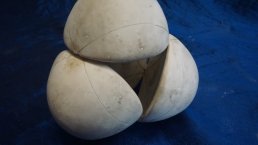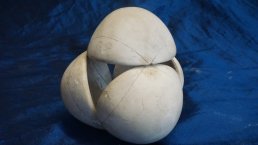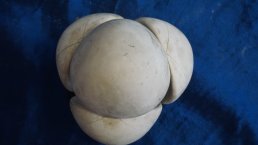Quartics with tetrahedral Symmetry
Models with tetrahedral Symmetry
In 1862, Kummer himself was involved in the building of several models of quartic surfaces. This family of models is obtained by varying the real parameters $\lambda$ and $\mu$ in the equation $$(\phi_{\mu}(x, y, z))^2 - \lambda p(x, y, z) q(x, y, z) r(x, y, z) s(x, y, z) = 0$$where $\phi_{\mu} = x^2 + y^2 + z^2 - \mu$ and $p, q, r, s$ are degree one polynomials. Let us denote the surface defined by this equation by $K$. Clearly $\phi_{\mu} = 0$ defines a sphere of radius $\sqrt{\mu}$, which we call $S_{\mu}$. The equations $p=0, q=0, r=0, s=0$ define four planes which, in this series of models, are chosen to form a regular tetrahedron concentric with $S_\mu$; we call it $T$. $K$ is a quartic surface: each of $p, q, r, s$ have degree one, and multiply to become degree four, while $\phi_{\mu}$ is degree two, squaring to become degree four as well. The parameter $\lambda$ determines how the sphere $S_{\mu}$ and tetrahedron $T$ interact, and determines the "shape" of the surface $K$.
More precisely, $$\begin{array}{c} p = z - 1 + \sqrt{2} x \\ q = z - 1 - \sqrt{2} x \\ r = -z - 1 + \sqrt{2} y \\ s = -z - 1 - \sqrt{2} y \end{array}$$
Model IX 1 shows $K$ for values $\mu=1$ and $\lambda= -1/8$.
Sadly our copy of model IX 2, for which $\mu=1$ and $\lambda=9/10$, is badly damaged, but see here for an intact model in Göttingen.
As can be seen from the variety in appearance of these models, varying $\mu$ and $\lambda$ can have significant effects. Let us first explore the effect on the sphere and tetrahedron of varying $\mu$, before examining the specific values in each of our models. At points where $S_{\mu}$ and the edges of $T$ intersect, $K$ is singular. We will see that $\mu$ determines the type and location of such singularities.
If $\mu <1$ then $S_{\mu}$ is entirely contained within the frame formed by $T$'s edges. Hence the edges do not intersect the sphere (at real points - recall our discussion of real and complex surfaces in Singularities), which is a somewhat degenerate case.
If $\mu = 1$ then $S_{\mu}$ meets $T$'s six edges tangentially. This gives six double points. This case is exhibited by Model IX 1, for $\lambda < 0 $. Similarly, IX 2 shows such a quartic, but this time the four tangent planes at the nodes are complex.
For $\lambda = 0$ we have the degenerate case of a double sphere. Changing the sign of $\lambda$ alters the shape of $K$ significantly. This can be seen by comparing IX 1 and IX 2. For the model IX 2, $\lambda$ is positive, and for IX 1 it is negative. This pair of surfaces was chosen by Kummer to show the amazing property that the space occupied by IX 1 becomes empty when we change to IX 2, and vice versa.
In terms of modern classification of singularities, we have six $A_{3}$ double points in each model.
The wire rings on IX 2 show where the four tetrahedral planes (as discussed above) meet the surface: each plane meets in a circle. These are double-planes, as discussed in Kummer Surfaces. In this case, each double plane meets 3 double points, and each double point is contained in 3 double planes. Likewise for IX 1.
Note that models IX 1 and IX 2 have the same symmetries as a tetrahedron, as does Steiner's surface. This means (informally) that they can be rotated and reflected in the same ways as a tetrahedron, and still look exactly the same.
[show-siblings]






